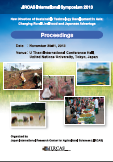Rice Mechanization in Asia

Rice Production in Asia
Asian countries are occupying 89% of the world total paddy area, and producing 90% of the total rice
production. In the last 8 years, the sales of Kubota’s tractors, combine harvesters and rice planters in Asia
have increased very rapidly, especially in China, Thailand, Vietnam and India. In other Asian countries,
the mechanization of farming has just started or is going to start in the near future. In most Asian countries
where economic growth and population are exploding, the shortage of agriculture labor, income gap
between cities and villages, risk of stable food supply to the rapidly growing population are common
subjects.
Rice Transplanter for Asian Market
1. Saving labor cost
Shortage of labor for manual rice planting can cause the failure of scheduled transplanting. Manual rice
transplanting needs 8hrs of work by 20 labors for 1ha of paddy field. A transplanter needs 2 persons and
8hrs of work for 1ha paddy. The total working hours are only 16hrs. The rice transplanter can realize low
cost production and higher rice yield. With the rice transplanter, farmer needs only 2 persons to control
the transplanter.
2. Yield Increase
The transplanting system can also increase rice yield. The key factor in increased yield is to transplant
young two-week-old seedlings compared to four-week-old seedlings in manual transplanting. Younger
rice seedlings grow vigorously under better airflow and higher sun exposure conditions, resulting in higher
shoot numbers and yield than manual planting. With the manual planting system, four-week-old seedlings,
with less room for further growth, are used. Insufficient air and sunlight reduce growth and increase
disease risk.
3. Production at Low Cost
Compared to manual planting, a transplanter plants young seedlings with regular space and can decrease
rice seedling costs by 57%.
4. Making Transplanter More Popular
In South East and South Asian countries, farmers are usually reluctant to adopt new methods, being
afraid of higher risk in rice production. Our first approach is to make raising seedlings for transplanters,
popular among farmers in those areas.
Tractor for Asian Market
Kubota is now proposing the use of tractor with rotary tiller for rice paddies in South East Asia. There
are differences in soil size between cultivators and our rotary tillers. With rotary tiller, soil is finished
smoothly. With the help of rotary cover, land leveling can be done at the same time as rotary cultivation.
Kubota tractor with rotary tiller creates good soil conditions for rice production. Light Kubota Tractor is
most suitable for works in a paddy field. Heavy weight ordinary tractor destroys the hard pan of paddy.
Once tires sink into soil, work efficiency of heavy tractors decreases so badly. Light body weighted
Kubota tractor will not disturb the soil hard pan. Rice transplanter keeping a stable posture on soil hard
pan can be operated with higher efficiency. As a result, seedlings are uniformly planted. The “Light
weight” of Kubota tractor is most suited for many operations on paddy fields. Ordinary heavy tractor can
easily destroy soil hard pan. Tires of heavy tractors often sink into the soil and badly reduce work efficiency.
The rice transplanter keeping a stable position on hard pan can work more efficiently and can uniformly transplant rice seedlings. Other great advantages of Kubota tractor are the four-wheel drive (4WD) system
and the waterproof structure. The first advantage is the increased traction of 4WD system making uniform
and deep tillage easy. The second advantage is the decreased slippage of the light-weight tractor, the third
advantage is reduced soil compaction and damage to soil hard pan. The third advantage is enabling the
light-weight tractor to work more efficiently in a paddy field without cage wheels that are necessary, are
not required like a traditional heavy tractor. Fourthly, waterproof structure including front axle is designed
to prevent break-downs caused by water flowing into chassis in a wet paddy field. For all of these reasons,
Kubota tractor is best fitted for the use in a wet paddy field.
Harvester
In Asia, contracting harvest is becoming popular business. Combine owners undertake harvest of crops
for farmers at a reasonable price. Highly efficient and durable harvesters are required by customers. We
have introduced Combine Harvesters in the Asian market since 1998 and have sold more than 100 thousand
units since then.
Kubota produces two types of combines. One is a head-feeder type and the other is a conventional type.
Head-feeder type used in East Asia is suitable for harvesting japonica rice. In South and Southeast Asia,
the conventional type of combine harvester is popular and suitable for Indica rice. We have three models
of conventional type combines to match different field conditions.
Kubota has developed a wide range of products from cultivator to combine harvester for the
mechanization of farming. Kubota wants to contribute to the development of farming systems of Asian
countries through the development of farm machineries, meeting the demands of farmers.
| Date of issued | |
|---|---|
| Creator | Joji Arihara |
| Publisher | Japan International Research Center for Agricultural Sciences |
| Available Online | |
| Issue | 2013 |
| spage | 86 |
| epage | 97 |
| Rights | Japan International Research Center for Agricultural Sciences |
| Language | eng |
